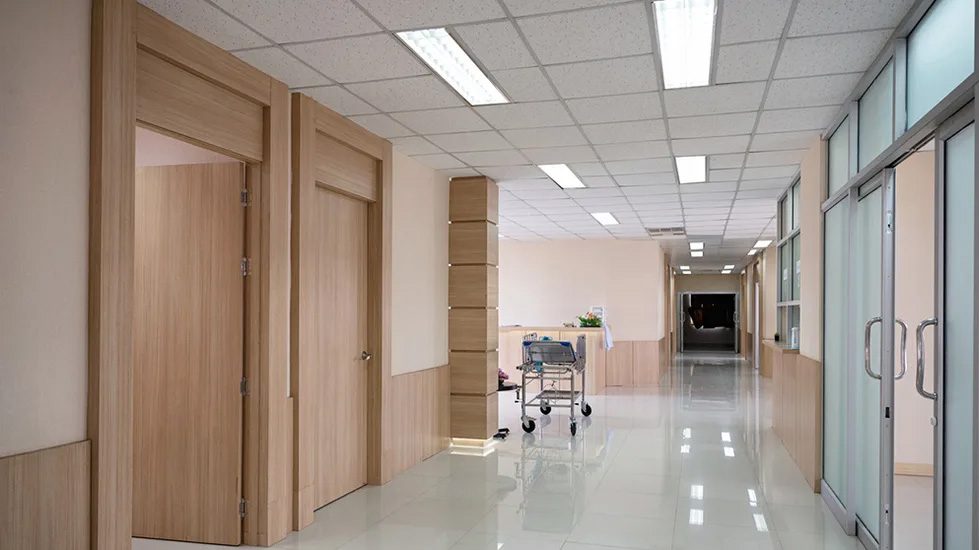More wooden architecture in schools and hospitals
March 31, 2023

Within the Swiss real estate market, healthcare and educational buildings are playing an increasing role in terms of timber construction – here is an overview of what this means in economic terms.
Besides the ecological aspects, the choice of wood as a building material has several other advantages, such as good tactile qualities and providing a pleasant indoor climate. The well-being of children, schoolchildren, and students in interior spaces is becoming an increasing consideration in the design of new buildings. Wood is even said to improve the ability to concentrate. Patients also benefit from this natural building material, as it is said to have a positive effect on the healing process, and modular wood construction offers numerous advantages too.
An increasing number of investors
Educational buildings include not just schools for compulsory and tertiary education, but also places for childcare, further education and student housing, as well as special premises such as libraries. The largest owner of educational real estate – and the most important investor in this segment – is the public sector. Wüest Partner has estimated its portfolio to be around CHF 90 billion in 2020. It is responsible for 89% of building permit applications1 in the education sector, most of which are for public schools. Other investors include incorporated (AGs) and limited (GmbHs) companies (4%), foundations (3%), and also private individuals (1%). These investors usually combine educational spaces with those for other uses.
Investors play a more active role in healthcare buildings than in educational facilities. In hospital construction, incorporated and limited companies are the main type of owners (61%), ahead of associations/foundations (20%) and the public sector (18%).2 Wüest Partner estimates that healthcare buildings account for around 5-10% of the residential market. The transition from the open market to retirement housing is fluid. Healthcare buildings include healthcare facilities and homes (15533), senior residences, and clinics and hospitals (2762). Overall, the real estate market for healthcare buildings is attracting increasingly more investors.
Market share of wood construction
The market share of wooden load-bearing structures in new, non-residential construction has remained stable since 2019, at around 10.5%. To date, wood continues to be used most for agricultural buildings, followed by healthcare buildings in second place and educational, cultural, and recreational buildings in third place.
Compared to previous years, the market share of wood in healthcare buildings has risen sharply and, at 15.6%, is higher than ever before. Here, the shares of wood and lightweight construction are in the same order of magnitude, with peaks sometimes alternating. To what extent load-bearing constructions made of wood will serve as an alternative to (temporary) lightweight constructions in healthcare buildings or establish themselves in (replacement) new buildings will become apparent in the coming years. However, pioneering projects, such as the new building for the Children's Hospital in Zurich or the Aarhus Residents' House in Gümlige, Bern, have already begun laying the foundations.
The use of wood in educational buildings has risen to just over 10% (currently 11.6%).
Modular buildings in the healthcare and education sector
Modular wood construction is particularly suitable for the creation of temporary structures that help maintain healthcare or educational facilities during a building project. These temporary structures can be erected quickly due to their high degree of prefabrication, and are easy to dismantle and remove. In the best case, they can even be reassembled and reused in other locations. Moreover, lower loads and often the omission of a basement simplify complex and costly civil engineering work.
Modular buildings are also suitable for use as permanent installations with repetitive basic structures, as is often the case with healthcare and educational buildings. Thus, classrooms and patient rooms can be designed efficiently. In fact, modular buildings are gaining more recognition in educational construction, which the numbers reflect. In the last ten years, a total of 46 modular healthcare buildings have been submitted for approval, 14 (30%) of which were wood. The number of educational buildings is much higher: 246 projects involved modular construction, 88 of which were made of wood. The investment amount for wooden modular buildings for health and education facilities does show strong fluctuations over the years. Nevertheless, over the period from 2012 to 2022, an impressive 34% (341 million of 1000 million CHF) of the investment was spent on wooden modular buildings.
Notes
- Period 2017-2020
Key figures of Swiss hospitals 3/2022 - Federal office for statistics, 2020
This article originally appeared in espazium's special issue "Stadt aus Holz - Bildungsbauten aus Holz".